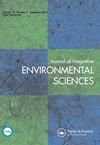泥炭地耕作系统可持续吗?评估印度尼西亚加里曼丹中部泥炭地现有农业系统的案例研究
IF 3.5
4区 环境科学与生态学
Q3 ENVIRONMENTAL SCIENCES
Journal of Integrative Environmental Sciences
Pub Date : 2018-01-01
DOI:10.1080/1943815X.2017.1412326
引用次数: 34
摘要
泥炭地可以开垦为农业用地,在经济上具有重要作用。浅泥炭(<100厘米)可用于种植包括蔬菜在内的粮食作物。泥炭地也成为发展大型油棕和橡胶种植园的吸引力。然而,泥炭地在温室气体(GHG)排放方面存在一些限制,特别是退化泥炭地的二氧化碳排放。这些是由泥炭分解产生的。根据常识,管理退化泥炭地温室气体排放有三种选择:保护和恢复、自然恢复和农业利用。在这种情况下,面临的挑战是利用退化的热带泥炭地用于农业,同时避免负面影响,并确保其环境可持续性。这项研究试图为制定更好的管理计划作出贡献。研究结果表明,退化泥炭地水稻种植的可持续性得分最高。水稻种植的可持续性得分为52.14%,油棕和橡胶种植的可持续性得分分别为47.55%和47.67%。因此,水稻种植可以被认为是开发退化泥炭地的第一选择。如果能够改善油棕和橡胶种植系统的可持续性,随后也可以考虑改进它们。本文章由计算机程序翻译,如有差异,请以英文原文为准。
Are peatland farming systems sustainable? Case study on assessing existing farming systems in the peatland of Central Kalimantan, Indonesia
Abstract Economically, peatland plays an important role since they can be reclaimed for agriculture. Shallow peat (<100 cm) can be used to grow food crops including vegetables. Peatland has also become attractive for development of large-scale oil palm and rubber plantations. However, peatland has a number of constraints in terms of greenhouse gas (GHG) emission, especially CO2 emissions in the degraded peatland. These arise from decomposition of peat. Common sense suggests three alternatives to manage GHG emissions from degraded peatland: conservation and restoration, natural recovery, and agricultural use. In this context, the challenge is to utilize degraded tropical peatland for agriculture while avoiding the negative impacts, and ensuring its environmental sustainability. This research attempts to contribute toward developing better management plans. Results of this study show that rice farming has highest sustainable score in degraded peatland. Rice farming secured a 52.14% sustainability score, while oil palm and rubber farming exhibited 47.55 and 47.67% sustainable scores, respectively. Therefore, rice farming can be considered as the first alternative for development of degraded peatland. Improved oil palm and rubber farming systems may also be subsequently considered if their sustainability can be improved.
求助全文
通过发布文献求助,成功后即可免费获取论文全文。
去求助
来源期刊

Journal of Integrative Environmental Sciences
ENVIRONMENTAL SCIENCES-
CiteScore
3.90
自引率
0.00%
发文量
13
审稿时长
>12 weeks
期刊介绍:
Journal of Integrative Environmental Sciences (JIES) provides a stimulating, informative and critical forum for intellectual debate on significant environmental issues. It brings together perspectives from a wide range of disciplines and methodologies in both the social and natural sciences in an effort to develop integrative knowledge about the processes responsible for environmental change. The Journal is especially concerned with the relationships between science, society and policy and one of its key aims is to advance understanding of the theory and practice of sustainable development.
 求助内容:
求助内容: 应助结果提醒方式:
应助结果提醒方式:


